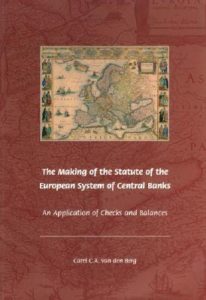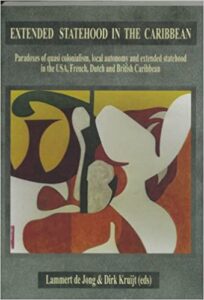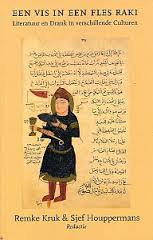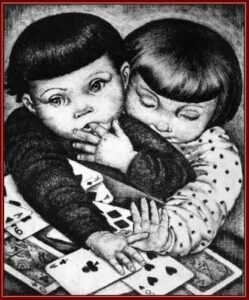Carel C.A. van den Berg – The Making Of The Statute Of The European System Of Central Banks
 You can download the complete book (PDF-file) here: CCAvdBerg – MakingofStatute
You can download the complete book (PDF-file) here: CCAvdBerg – MakingofStatute
Dutch University Press, Amsterdam, 2004, 2005 ISBN 90 3169 292 7 – This book is the commercial edition of the dissertation defended and approved at the Faculty of Economics and Business Administration of the Vrije Universiteit of Amsterdam on 29 October 2004 . Thesis printed by Thela Thesis – ISBN 90 5170 997 8 (2004).
Zur Thematik
The creation of the Economic and Monetary Union (EMU) is one of the most profound steps in the monetary history of Europe, which has significance not only for professionals, politicians and academics, but also for everyday life. Among the accomplishments that stand out are the establishment of a federally structured European System of Central Banks (ESCB)[i]and the introduction of a single currency. The opinions and decisions of the European Central Bank (ECB)[ii] are almost daily topics for the national newspapers, discussions on its accountability (or perceived lack thereof) are recurrent topics in the European Parliament and political and academic circles. In short, the ECB has become a reality for almost everyone within a couple of years since its establishment. Technically it has been successful: the transition from national currencies to a single currency, the euro, has been a remarkably smooth process despite the gigantic scale of the operation. Though it is too early to evaluate how effective the ECB is in implementing its mandate, for the Monetary Union as a whole inflation rates are lower than they were during a large part of the nineties.
The legal underpinnings of the System and its independence have been extensively studied, see e.g. Stadler (1996), Smits (1997) and also Endler (1998). Also, from a political angle, the degree in which the negotiations leading up to the signing of the so-called Treaty of Maastricht in February 1992 could be characterized as a success for the German or for the French negotiators has been analyzed, e.g. by Viebig (1999) and Dyson/Featherstone (1999). In many respects these authors have concluded that it was a German success. However, the ESCB is not a copy of an existing central bank, not even the Bundesbank. It has been established on the basis of a unique Statute.[iii] This Statute will guide the ECB, also in the future. But like many texts, the Statute is sometimes ambiguous. For a right interpretation of the texts it is important to know their genesis. Sometimes wording was copied from existing other texts, sometimes texts are a delicate compromise, sometimes texts have a difficult technical history.
What distinguishes this study from these other studies is that these studies analyzed the ESCB from only one perspective, i.e. either from a legal, political or economic point of view. This study aims to show how political, economic and institutional considerations were combined and have found their way into the (legal) wording of the ESCB Statute. To this end I focus on each article, describing the economic rationale behind it as well as its genesis, systematically using historical sources which until now have not been used for these purposes. The perspective I take in order to interpret, analyse and assess the Statute of the ESCB is that of checks and balances. We will identify and study the ‘checks and balances’ which have been introduced in the Statute of the ESCB. ‘Checks and balances’ are an important characteristic of any federally designed system. They are part of the ‘rules of the game’, which have to be taken into account by the components of the system, which rules should ensure the system’s stability and effectiveness. For instance, ‘checks and balances’ prevent the possibility of ‘winner takes all’, because this would mean the end of the federal character. A clear normative framework for checks and balances for federal central bank systems is not available, though there are general notions which any workable system of checks and balances has to accord with. Therefore, we will develop a framework to describe the checks and balances in central bank systems.
The concept of checks and counterchecks also played a role when the American central bank system (the Federal Reserve System, FRS) was designed. A nice description can be found in P.M. Warburg in his book ‘The Federal Reserve System, Its Origins and Growth’ (1930), p. 166: ‘The position of the Reserve Board, as designed in the Act [of 1913], was bound to prove exasperatingly difficult and trying. The office was burdened with the handicap, commonly imposed upon so many branches of administration in a democracy, of a system of checks and counter-checks – a paralyzing system which gives powers with one hand and takes them away with the other. […] Success or failure in such cases generally depends on the wisdom with which the balancing of the checks and counter-checks in a legislative act is handled, and on the intelligence with which, later on, the act is administered.’ And ibidem p. 170: ‘[….] many attempts were made to find a satisfactory answer to the tantalizing puzzle of how to safeguard the autonomy of the reserve banks while giving, at the same time, adequate coordinating and directing powers to the Reserve Board.’ From our study it appears that these considerations were still relevant for the conception of the European central bank.
Auke van der Berg – Ikki’s eiland. De horzel van het koninkrijk I. Het gesprek
 Download hier het complete boek (PDF): Ikki’seiland: Het gesprek
Download hier het complete boek (PDF): Ikki’seiland: Het gesprek
Lees ook: http://ikkiseiland.com
Ikki stuurt en lacht en praat. Hij kent iedere steen, elke hobbel en alle bochten in de weg.
‘De Bonairiaan blaft graag. Hij is net als de hond. Die eet geen gras, maar als hij geiten gras ziet eten, blaft hij hard.’
Ikki lacht.
‘Begrijp je wat ik bedoel?’
Zijn rechterwijsvinger hangt even streng in de lucht.
‘Wij moeten niet afhankelijk zijn. Niet alleen de hand ophouden. Wat ga je doen als je iedere maand zomaar geld krijgt? Niets toch?’
Ikki schudt zijn hoofd. Hij vindt het maar niks dat een deel van de bevolking niet erg enthousiast aan haar toekomst knutselt.
‘Ik hou van mijn land. Ik wil dat het vooruitgaat. Dat wij zelf de baas zijn.’
Hij toetert. Hij doet het raampje open en groet de oude dame die op een rode plastic stoel onder een boom zit.
‘Mijn vroegere buurvrouw. Vorige week werd ze zomaar ziek. Heb ik haar ‘s ochtends om zes uur naar het ziekenhuis gebracht. Ze is tweeëntachtig. Na een paar uur kon ik haar weer ophalen. Was ze weer helemaal gezond. Een klein virusje dus. Begrijp je wat ik bedoel?’
‘Ik wil deze week graag een paar keer wat langer met je praten’, zeg ik, ‘gaan we het over alles hebben.’
‘Alles?’, vraagt Ikki, ‘ik weet niet alles.’
Hij schiet weer in de lach.
‘Maar ik weet wel hoe het moet, hoor.’
‘Dan ben je deze week voor een paar uur directeur van het eiland.’
‘Dat is goed.’
Ikki kijkt nu serieus.
‘Ik ga je veel vertellen. Over mijn eiland, over de mensen en de geschiedenis.’
Lammert de Jong & Dirk Kruijt (eds). Extended Statehood in the Caribbean Paradoxes of quasi colonialism, local autonomy and extended statehood in the USA, French, Dutch and British Caribbean
 Lammert de Jong & Dirk Kruijt (eds). – Extended Statehood in the Caribbean Paradoxes of quasi colonialism, local autonomy and extended statehood in the USA, French, Dutch and British Caribbean
Lammert de Jong & Dirk Kruijt (eds). – Extended Statehood in the Caribbean Paradoxes of quasi colonialism, local autonomy and extended statehood in the USA, French, Dutch and British Caribbean
Rozenberg Publishers 2005 – ISBN 90 5170 686 3
Het complete boek (PDF): 070211ExtendedStatehood
Zie voor RQ -online versie: https://rozenbergquarterly.com/extended-statehood-in-the-caribbean
Remke Kruk & Sjef Houppermans (red.) – Een vis in een fles raki – Literatuur en Drank in verschillende culturen
 Download hier het complete boek (PDF): Een vis in een fles Raki
Download hier het complete boek (PDF): Een vis in een fles Raki
Zie voor RQ -online versie: https://rozenbergquarterly.com/een-vis-in-een-fles-raki-literatuur-en-drank-in-verschillende-culturen-inhoudsopgave/
Uit de Inleiding:
Misschien is de belangrijkste trek die alcohol met literatuur gemeen heeft wel zijn sublieme vluchtigheid. Vederlichte extases voor wie een ogenblik aan de verveling van het bestaan wil ontkomen of strategische vervoering om de grenzen van de zwaartekracht te verkennen. Zelfs de zwartste romans uit de naturalistische koker gaan op de tenen lopen als het alcoholpercentage stijgt, en de verschrikkingen van het delirium tremens gaan meestal toch gepaard met zotte spotlachjes of dromen van een overkant. Inspiratie lijkt als twee druppels wodka op een roes en dichterlijke verzen spreken vaak een nostalgie naar het bacchantenleven uit. Het boek en de fles zijn zo een onlosmakelijk duo in schertsende dialoog of in vinnig twistgesprek.
Natuurlijk kent de relatie tussen de letteren en de etherische genoegens van de drank vele varianten, zowel wanneer men langs de lijnen van de geschiedenis kijkt als ook wanneer verschillende culturen nader beschouwd worden. De voorliggende verzameling van rond alcohol gesitueerde essays tracht deze menigvoud steekproefsgewijs in beeld te brengen waarbij trouwens ook de betrokkenheid van de auteur bij de drank kan variëren: van de nuchtere dronkenschap die Sem Dresden Montaigne toedichtte tot de ultieme helderheid van het laatste glas bij Malcolm Lowry.
Wanneer we even de alcohol als decorvulling buiten beschouwing laten (ook al is dan inderdaad het decor vlug overvol gelijk in de western waar we voorvoelen dat het eerste uitgeschonken glas in de bar onherroepelijk leidt tot een vuurgevecht waarbij alle flessen door de spiegelwand worden geprojecteerd), kunnen we een viertal mise en scènes onderkennen die samen de horizon van behoefte, vraag en verlangen afbakenen.
Arij Ouweneel – Gabriel Garcia Marquez 1927 – 2014. Terug naar Macondo – Het spook van Honderd jaar eenzaamheid en het inheemse innerlijk van de Mesties
 Arij Ouweneel- Gabriel Garcia Marquez 1927 – 2014. Terug naar Macondo – Het spook van Honderd jaar eenzaamheid en het inheemse innerlijk van de Mesties
Arij Ouweneel- Gabriel Garcia Marquez 1927 – 2014. Terug naar Macondo – Het spook van Honderd jaar eenzaamheid en het inheemse innerlijk van de Mesties
Rozenberg Publishers 2007
ISBN 978 90 5170 813 4
Download hier het complete boek (PDF): Ouweneel – Marquez
Terug naar Macondo begon met een lezing van de roman Honderd jaar eenzaamheid(1967) van de Colombiaanse schrijver Gabriel García Márquez. ’s Avonds, thuis op de bank. In die periode was ik al uitvoerig bezig met een sociaal-cultureel wetenschappelijk onderzoek naar de continuïteit van de inheemse cultuur van Latijns-Amerika. Ik had mij verdiept in de amerindiaanse scheppingsverhalen, zoals die van de Maya’s, de Azteken, de Inka’s, de Mapuche en diverse Amazonevolken. Ofschoon het lezen van García Márquez’ roman in feite niets met mijn academische onderzoekswerk van doen had, kreeg ik al spoedig last van een déjà vu. Ik had als het ware Honderd jaar eenzaamheid al gelezen in die scheppingverhalen maar wist tegelijkertijd dat García Márquez zich nooit een indio, indígena, inheemse of amerindiaan had genoemd. Integendeel, als er amerindio’s in zijn werk voorkomen dan voert hij ze op als behorend tot een andere wereld. Als hij naar eigen zeggen iets is, dan een caribeño, een inwoner van het Caraïbische Gebied van Colombia. Ik wist ook dat de inheemse geschiedenis van Colombia moeilijk op één lijn te plaatsen is met die van Mexico, Guatemala, Ecuador, Peru of Bolivia. Voor romans die de inheemse wereldvisie presenteren moest ik werken van de Peruaan José María Arguedas (1911-1969) of de Guatemalteek Miguel Ángel Asturias (1899-1974), winnaar van de Nobelprijs in 1967, uit de bibliotheek halen. Het was bekend dat Asturias zich diepgravend had ingeleefd in de Maya wereld en dat Arguedas romans en verhalen schreef die waren gebaseerd op zijn jeugd in een Quechua omgeving. Het kon niet zijn dat García Márquez tot hun wereld behoorde. Bovendien, Honderd jaar eenzaamheid was vooral een succes onder de mestiezen van Mexico, Colombia, Peru, Ecuador, Argentinië en nog enkele landen. En waarom zouden mestiezen zich identificeren met een amerindiaans scheppingsverhaal?
Zie voor RQ-online versie: https://rozenbergquarterly.com/gabriel-garcia-marques/
Yvon van der Pijl – Levende-Doden ~ Afrikaans-Surinaamse percepties, praktijken en rituelen rondom dood en rouw
 Yvon van der Pijl – Levende-Doden ~ Afrikaans-Surinaamse percepties, praktijken en rituelen rondom dood en rouw.
Yvon van der Pijl – Levende-Doden ~ Afrikaans-Surinaamse percepties, praktijken en rituelen rondom dood en rouw.
Bronnen voor de Studie van Suriname (BSS) Nummer 27 – IBS/Rozenberg Publishers – Utrecht-Amsterdam 2007 – ISBN 978 90 5170 923 0
Het complete boek (PDF) kunt u hier downloaden: Yvonvd Pijl-Levende doden
Zie voor RQ -online versie: https://rozenbergquarterly.com/levende-doden-afrikaans-surinaamse-percepties-praktijken-en-rituelen-rondom-dood-en-rouw-inhoud/
Rituelen rondom dood, begraven en rouw vormen binnen de Afrikaans-Surinaamse leefwereld de belangrijkste rites de passage.
Dit boek richt zich grotendeels op de etnografische beschrijving en interpretatie van het rituele proces dat start aan het sterfbed of zelfs vóórdat het ‘finale’ doodsuur geslagen heeft. De studie leunt hierbij op klassiek antropologische benaderingen van overgangsrituelen, maar doet dit niet zonder hedendaagse ontwikkelingen, zoals de medicalisering, privatisering en commercialisering van de dood, in de analyse te betrekken. In Suriname vindt immers, net als in andere samenlevingen, een zekere verdringing van de dood plaats, waardoor de behoefte aan alle pranpran (rituele ophef) tanende is. Tegelijkertijd is onder invloed van Creools nationalisme, groeiend zwart bewustzijn, roots-zoektochten en heimweetoerisme van blaka bakra (Creoolse Nederlanders) een zekere retraditionalisering van bepaalde praktijken waar te nemen.
‘Levende-doden’ voorziet in een duiding van deze paradoxale ontwikkelingen en presenteert, vanuit historisch perspectief, de hedendaagse Afrikaans- Surinaamse doodscultuur als een hybride viering, waarin (herontdekte) tradities uit verschillende religieus-spirituele oriëntaties, moderne, gemondialiseerde cultuurelementen en verscheidene vormen van conspicuous consumption verweven zijn.



